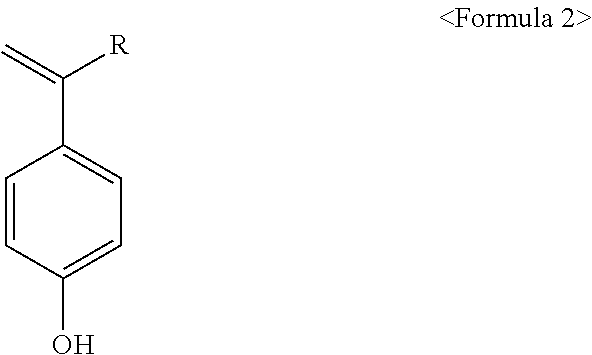Modified monomer, modified polymer including the same, and methods of preparing the same
a monomer and polymer technology, applied in the field of modified monomer and modified polymer including the same, can solve the problems of low wet skid resistance of materials, poor dispersibility, and insufficient effect of materials, and achieve high anionic reactivity, easy reaction, and strong affinity
- Summary
- Abstract
- Description
- Claims
- Application Information
AI Technical Summary
Benefits of technology
Problems solved by technology
Method used
Image
Examples
preparation example 2
2-methoxyethoxy)ethoxy)-4-vinylbenzene
1) Preparation of Hydroxystyrene
[0033]0.275 mol of sodium hydroxide was put into a 500 ml round-bottom flask, 60 ml of anhydrous ethanol was added thereto to dissolve the sodium hydroxide, and then 0.065 mol of acetoxystyrene was added to the flask, and the resulting solution was stirred at room temperature in a nitrogen atmosphere for 4 hours. Subsequently, 50 ml of distilled water and 30 ml of ethyl acetate were sequentially added to the resulting mixture to extract an organic layer, and the organic layer extraction process was repeated three times. The extracted organic layer was dried with anhydrous magnesium sulfate and filtered to remove the remaining moisture. Thereafter, the solvent was removed under reduced pressure to obtain 7.54 g (yield: 96%) of yellow solid hydroxystyrene. 1H NMR spectroscopic data of the purified hydroxystyrene is as follows.
[0034]1H-NMR (500 MHz, CDCl3) δ 7.31-7.29 (d, J=9.5, 1H), δ 6.80-6.78 (d, J=8.5, Ar—H, 2H),...
example 1
on of Modified Styrene Polymer
[0037]28.8 mmol of styrene and 1.4 mmol of the styrene-based compound prepared according to Preparation Example 2 were put into a 100 ml Schlenk flask, 30 ml of anhydrous n-hexane was added thereto, and then the temperature inside the flask was raised to 40° C. When the temperature inside the reactor reached 40° C., 0.25 ml (0.63 mmol in hexane) of a 2.5 M n-butyl lithium hexane solution was added to the reactor to allow an adiabatic heating reaction to occur. After about 20 minutes, the polymerization reaction was terminated using methanol to complete the preparation of a modified styrene polymer.
example 2
on of Modified Styrene Polymer
[0038]A modified styrene polymer was prepared in the same manner as in Example 1, except that 2.9 mmol of the styrene-based compound of Preparation Example 2 was added.
PUM
| Property | Measurement | Unit |
|---|---|---|
| wt % | aaaaa | aaaaa |
| molecular weight distribution | aaaaa | aaaaa |
| temperature | aaaaa | aaaaa |
Abstract
Description
Claims
Application Information
 Login to View More
Login to View More - R&D
- Intellectual Property
- Life Sciences
- Materials
- Tech Scout
- Unparalleled Data Quality
- Higher Quality Content
- 60% Fewer Hallucinations
Browse by: Latest US Patents, China's latest patents, Technical Efficacy Thesaurus, Application Domain, Technology Topic, Popular Technical Reports.
© 2025 PatSnap. All rights reserved.Legal|Privacy policy|Modern Slavery Act Transparency Statement|Sitemap|About US| Contact US: help@patsnap.com



